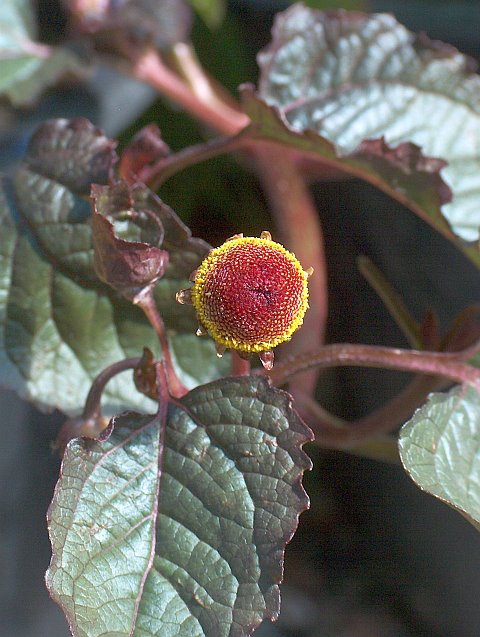3 otters swimming across the bay again this morning:
….which reminds me of this song by Harvey Andrews, a folk singer who often played support to rock bands in England in the 70s.
3 otters swimming across the bay again this morning:
….which reminds me of this song by Harvey Andrews, a folk singer who often played support to rock bands in England in the 70s.
Serving a side-salad of leaves of Acmella (Spilanthes) oleracea is guaranteed to get the juices flowing and lead to a lively discussion at dinner… Widely known as the Toothache plant as chewing the leaves/flowers has an analgesic (numbing) effect: “Eating a whole flower bud results in a grassy taste, followed by an extremely strong tingling or numbing sensation and often excessive saliva production and a cooling sensation in the throat”. Hence also the alternative name Buzz Balls (the flower buds). I would describe the initial taste explosion as citrousy. It’s not true that you start frothing excessively from the mouth on chewing some leaves. :) The effect is due to the presence of spilanthol… I usually have a pot or two of this plant in my garden to give a bit of excitement to unsuspecting guests – they usually think I’ve poisoned them…. This is also a prime annual edimental as you can see in the picture from the Lund Botanical Garden in Sweden. However, it is unfortunate that slugs are mad on this plant and will quickly defoliate your plants if you turn your back! I therefore grow mine in pots so that I can keep them out of the reach of the slugs… This is a native of Brazil where it is commonly used in salads and it is also used as a green vegetable (cooking destroys the toothache effect). This album was stimulated by a post by Stine Syvertsen on the Planteklubben group when I first posted it on FB back in 2012. Stine wrote about this herb also being used in Madagascar where it is known as Anamalao. It grows well and sets seed most years with me…It is also used medicinally and is for example a traditional remedy to stammering! – it certainly stimulates the vocal chords is my experience! Another interesting use is that if you have a guest for dinner who doesn’t like chili, you don’t need to make a separate chili-free version of whatever you’re cooking, just give your guest a few Acmella leaves to chew first!





A blackcap (munk in Norwegian) was foraging the last yew berries this afternoon outside the kitchen window.
Sweet cicely (spansk kjørvel) is considered to be one of the worst invasive plants here and is now banned for sale and we don’t offer it through the Norwegian Seed Savers catalogue / yearbook. However, it’s one of the best edible perennials. It’s never spread in my garden as I’ve always eaten it, the best way to stop it spreading. In particular, eating the delicious flowers (in salads) and immature seeds (the best candy for kids) and collecting the mature seeds for winter sprouting, the best sprouts for winter stir-fries (sweet anise taste and a good size).
This year, I sowed the large seeds in a large pot and stratified outside for a couple of months before moving into the cellar where the temperature is warmer than usual this winter and there was mass germination a couple of weeks ago. A few will be used in a chinese style stir-fry tonight!
Eat your invasives!



Today at the Ringve Botanical Gardens I found the Allium garden was full of little workers eating the masses of birch seeds that had fallen during the winter….saving me a lot of work later. The first summer, there were thousands of birch seedlings in the garden…
Ever since I moved here in 1984, it’s been one of the year’s highlights to hear the first robin (rødstrupe) singing in the spring and I’ve recorded this event every year since. However, it’s with mixed feelings that I woke up to this year’s first song this morning, a full 7 weeks earlier than what was normal in the 80s and 2 weeks earlier than my previous record. In the city, birds have been heard singing since January in the record mild January here…
A great tit (kjøttmeis) accompanies the robin in the second video!

As Storm Dennis brought similar temperatures to southern England to Malvik, this was today's harvest from the garden....more like mid-April. These were used in a stew: Alliaria petiolata / hedge garlic / løkurt Hablitzia tamnoides / Caucasian spinach / stjernemelde Taraxacum officinale / dandelion / løvetann Allium cernuum / nodding onion / prærieløk Allium carinatum / keeled garlic / rosenløk Ficaria verna / lesser celandine / vårkål Brassica oleracea / perennial kales / flerårige kål (flere) Dystaenia takesimana / Korean celery / Koreansk selleri Rumex acetosa / sorrel / engsyre Rheum x rhabarbarum / rhubarb / rabarbra


Årets største registrerte kaie flokk i Trøndelag ble sett fra huset i ettermiddag, rundt 750 fugler (ja, jeg telte!) i to grupper over Malvikodden og Malvikbukta. De er på vei inn til verdens største overnattingsted for denne fuglearten så langt nord i verden som ligger ca 1km vest for huset mitt! De kan trekke 20-30 km inn til Vikhammer hver kveld fordi de føler seg trygge her og sikkert “diskuterer hvor de beste jaktmarkene er”! Lokaliteten på Vikhammer er et av Malvik kommunes viktigste lokalitetene for det biologiske mangfoldet (rapport fra 2010).
English: The largest recorded jackdaw (kaie) flock this year in this area seen from the house this afternoon, some 750 birds (yes, I counted!) in two groups over Malvikodden and the bay.